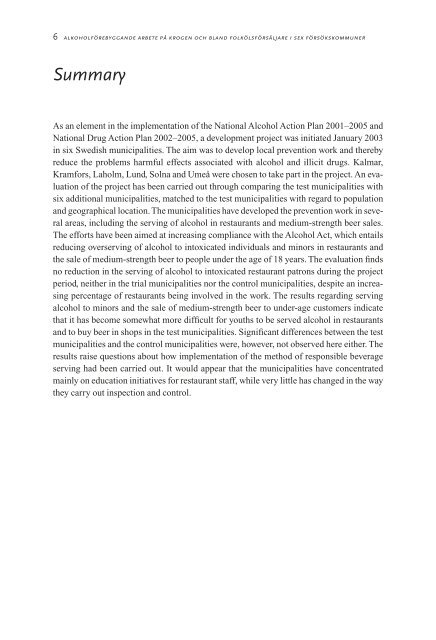Alkoholförebyggande arbete på krogen och bland folkölsförsäljare i ...
Alkoholförebyggande arbete på krogen och bland folkölsförsäljare i ...
Alkoholförebyggande arbete på krogen och bland folkölsförsäljare i ...
Create successful ePaper yourself
Turn your PDF publications into a flip-book with our unique Google optimized e-Paper software.
6 alkoholförebyggande <strong>arbete</strong> <strong>på</strong> <strong>krogen</strong> <strong>och</strong> <strong>bland</strong> <strong>folkölsförsäljare</strong> i sex försökskommuner<br />
Summary<br />
As an element in the implementation of the National Alcohol Action Plan 2001–2005 and<br />
National Drug Action Plan 2002–2005, a development project was initiated January 2003<br />
in six Swedish municipalities. The aim was to develop local prevention work and thereby<br />
reduce the problems harmful effects associated with alcohol and illicit drugs. Kalmar,<br />
Kramfors, Laholm, Lund, Solna and Umeå were chosen to take part in the project. An evaluation<br />
of the project has been carried out through comparing the test municipalities with<br />
six additional municipalities, matched to the test municipalities with regard to population<br />
and geographical location. The municipalities have developed the prevention work in several<br />
areas, including the serving of alcohol in restaurants and medium-strength beer sales.<br />
The efforts have been aimed at increasing compliance with the Alcohol Act, which entails<br />
reducing overserving of alcohol to intoxicated individuals and minors in restaurants and<br />
the sale of medium-strength beer to people under the age of 18 years. The evaluation finds<br />
no reduction in the serving of alcohol to intoxicated restaurant patrons during the project<br />
period, neither in the trial municipalities nor the control municipalities, despite an increasing<br />
percentage of restaurants being involved in the work. The results regarding serving<br />
alcohol to minors and the sale of medium-strength beer to under-age customers indicate<br />
that it has become somewhat more difficult for youths to be served alcohol in restaurants<br />
and to buy beer in shops in the test municipalities. Significant differences between the test<br />
municipalities and the control municipalities were, however, not observed here either. The<br />
results raise questions about how implementation of the method of responsible beverage<br />
serving had been carried out. It would appear that the municipalities have concentrated<br />
mainly on education initiatives for restaurant staff, while very little has changed in the way<br />
they carry out inspection and control.

















